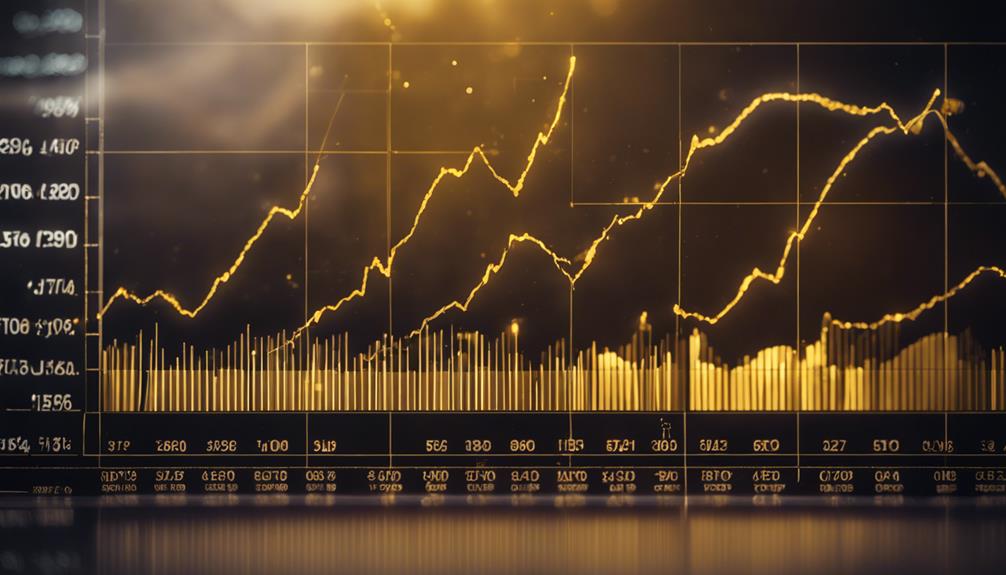Investing in Gold IRAs carries risks that investors need to be aware of. These risks include costs such as account setup, custodial, storage, and cash-out fees, as well as additional expenses for storage and insurance. Markups on gold sales and account closure fees can also affect investments. Gold investments are not easily liquidated, which can impact selling prices during market volatility. It is crucial to prioritize risk assessment in order to manage risks and potential benefits effectively. Taking the time to thoroughly understand the risks associated with Gold IRAs is essential for making informed decisions.
Key Takeaways
- High costs and fees associated with Gold IRAs can impact overall returns.
- Illiquidity of gold investments poses a challenge for investors.
- Risk assessments are crucial to understand and manage risks in Gold IRAs.
- Diversification is key to balancing risks and benefits in Gold IRAs.
- Regular reviews and adjustments help in minimizing vulnerabilities in Gold IRAs.
Potential Higher Maintenance Fees

Investors considering Gold IRAs should be mindful of the potentially elevated maintenance fees associated with this investment vehicle compared to traditional or Roth IRAs. These fees encompass various charges, including account setup fees, custodial fees, storage fees, and potential cash-out costs.
Account setup fees are incurred when establishing the Gold IRA, while custodial fees cover the services provided by the custodian overseeing the account. Storage fees are essential for safeguarding the physical gold held within the IRA. Additionally, investors should be aware of potential cash-out costs associated with liquidating gold assets.
These maintenance fees can have a significant impact on overall returns, making it important for investors to carefully evaluate the expenses involved when investing in a Gold IRA. Understanding these costs is crucial for effective portfolio management, as it enables investors to make informed decisions regarding their investment strategies and helps in evaluating the true value of holding a gold-backed IRA.
Additional Costs for Storage and Insurance

Given the extensive range of expenses linked to Gold IRAs, it is important to acknowledge the significant impact that additional costs for storage and insurance can have on the overall investment returns.
Storage costs for gold IRAs typically range from $100 to $300 per year, depending on the quantity of metal held. Additionally, insurance costs for safeguarding gold IRA storage can add an extra 1% to 2% of the value of the metals annually.
These expenses, along with secure storage fees, custodial fees, transaction fees, and maintenance costs, collectively contribute to the financial obligations of maintaining a gold IRA. It is essential for investors to thoroughly evaluate the viability of a gold IRA investment by factoring in these additional costs.
Understanding the implications of these expenses is important for making informed decisions regarding gold IRAs to ensure that the overall returns align with investment goals and expectations.
Markups on Gold Sales

Understanding the impact of markups on gold sales is vital for maximizing the potential profitability of gold investments in IRAs. When considering gold purchases, investors should be aware of the markups that can range from 5% to 10% or even higher. These markups can vary depending on the type of gold being purchased, whether it is coins, bars, or rounds.
To make cost-effective investments, it is essential to understand and compare markups offered by different gold dealers. Higher markups can greatly reduce the profitability of gold investments, especially for those who engage in frequent buying and selling activities.
Account Closure Fees

Upon closing a Gold IRA and liquidating holdings, investors may encounter account closure fees ranging from $100 to $300, depending on the custodian. These fees, distinct from storage costs or transaction fees, are vital components of an investor's exit strategy from their Gold IRA.
It is essential for investors to carefully review their custodian's fee schedule to understand the specific costs associated with closing their account. Account closure fees play a significant role in the overall risks of investing in Gold IRAs, as they can impact the returns realized upon exiting the investment.
Investors should factor in these fees when evaluating the potential profitability of their SEP Gold IRAs. Considering account closure fees alongside other expenses can help investors make informed decisions about their Gold IRA investments.
Illiquidity of Gold Investments

Understanding the world of Gold IRAs involves grasping the challenges posed by the illiquidity of gold investments. When considering liquidating gold from a Gold IRA, investors may face delays in accessing funds due to the time-consuming nature of the process. Converting gold into cash is not always immediate, highlighting the illiquidity of gold investments.
Selling gold for liquidity can be complex, influenced by market conditions and turnaround times. Investors need to carefully plan for potential cash requirements, taking into account the time needed to convert gold holdings into cash for their financial needs. The illiquidity of gold investments underscores the importance of strategic foresight and proactive management to navigate the complexities of accessing cash from gold holdings within a Gold IRA.
Volatility Impacting Selling Prices

The fluctuating nature of gold prices in Gold IRAs can be greatly influenced by market volatility. Gold price volatility, driven by market uncertainty and economic conditions, directly impacts the value of gold held in IRAs.
During periods of high volatility, selling prices can experience significant fluctuations, potentially leading to lower returns for investors. Price swings in the gold market need to be carefully considered when managing risks associated with Gold IRAs.
Understanding how volatility affects selling prices is important for investors looking to make informed decisions about buying or selling their gold assets. By staying informed about market trends and being aware of the potential impact of price swings, investors can better navigate the challenges posed by volatility in Gold IRAs.
It is essential to assess the risks involved in selling gold assets during volatile market conditions to make strategic investment decisions that align with one's financial goals and risk tolerance.
Importance of Risk Assessment

Evaluating the risks associated with Gold IRAs is crucial for investors to protect their financial interests. By thoroughly assessing risk factors such as market volatility and storage costs, individuals can make informed decisions.
Employing risk evaluation strategies, understanding the impact of risks, and utilizing risk mitigation techniques are essential components of managing the complexities of investing in Gold IRAs.
Risk Evaluation Strategies
Proper evaluation of risks is paramount for individuals considering investments in Gold IRAs, enabling them to make well-informed decisions. Utilizing risk evaluation strategies is essential in understanding the potential drawbacks associated with gold IRAs. Here are key aspects to take into account:
- Volatility: Evaluating the level of price fluctuation in the gold market.
- Illiquidity: Understanding the ease (or difficulty) of selling gold assets for cash.
- Market Fluctuations: Analyzing how external factors impact the value of gold investments.
Impact of Risk
Effective risk assessment plays a pivotal role in shaping investment decisions within the domain of Gold IRAs. Understanding the potential impact of risks associated with Gold IRAs is essential for investors.
By evaluating risks, investors can make informed choices, manage potential drawbacks, and balance their investment strategies effectively. Identifying and evaluating risks help in mitigating the drawbacks that may arise from investing in Gold IRAs.
Additionally, risk assessment assists in determining the suitability of Gold IRAs based on individual financial goals and risk tolerance levels. Hence, a thorough risk evaluation process is vital for investors to make well-informed decisions regarding their investments in Gold IRAs, ensuring alignment with their financial objectives and risk appetite.
Risk Mitigation Techniques
To navigate the risks inherent in investing in Gold IRAs, it is imperative for investors to strategically employ risk mitigation techniques that safeguard their investments and optimize their portfolio's resilience. When considering risk mitigation strategies, investors should:
- Conduct a thorough risk assessment to identify potential vulnerabilities and understand the impact of economic downturns on precious metals investments.
- Implement diversification by spreading Gold IRA holdings across various precious metals to reduce concentration risk and potential losses during market fluctuations.
- Evaluate the historical performance of gold in economic downturns to inform investment strategy adjustments and effectively manage risks posed by changing market conditions.
Regular reviews and adjustments to the investment strategy are important for adapting to evolving market dynamics and minimizing vulnerabilities.
Balancing Risks With Potential Benefits

Balancing risks with potential benefits in Gold IRAs requires a careful consideration of risk versus reward.
Diversifying investments can help mitigate the impact of market fluctuations on the overall portfolio.
Investors should weigh the long-term advantages of gold as a safe-haven asset against the short-term risks associated with price volatility.
Risk Vs Reward
When considering investments in Gold IRAs, it is important to carefully weigh the risks against the potential rewards to make informed financial decisions. Investors should conduct a thorough risk assessment to align their investment choices with their financial goals.
In the context of Gold IRAs, the following points highlight the delicate balance between risk and reward:
- Tax Advantages: Understanding the tax implications of Gold IRAs is vital for maximizing retirement savings.
- Portfolio Diversification: Gold IRAs can serve as a hedge against market volatility, enhancing portfolio resilience.
- Risk Management: Implementing effective risk management strategies can help mitigate storage costs and liquidity constraints associated with Gold IRAs.
Consider Diversification
Diversification plays a pivotal role in investment strategy as it involves spreading investments across various asset classes to minimize overall risk exposure.
When considering the risks and benefits of investing in gold IRAs, diversifying with precious metals can serve as a valuable component in a well-rounded portfolio. Gold IRAs offer a way to diversify traditional financial assets within individual retirement accounts, providing a hedge against market volatility and economic uncertainties.
Frequently Asked Questions
What Is the Downside of a Gold Ira?
One downside of a Gold IRA is its limited liquidity, as converting physical gold into cash can be a time-consuming process. This lack of immediate access to funds may hinder investors who require quick capital for various needs.
Additionally, the costs associated with storing physical gold in an approved depository could add to the overall expenses of maintaining a Gold IRA, potentially impacting the profitability and flexibility of the investment.
What Is the Truth About Gold Iras?
Gold IRAs offer investors a way to diversify their portfolios and hedge against economic uncertainties. By including gold, a tangible asset, in their retirement accounts, investors can potentially protect their wealth from inflation and market fluctuations.
However, it is vital to understand the associated costs, such as maintenance fees, storage expenses, and potential markups on selling prices. Educating oneself on these factors is essential for making informed decisions regarding gold IRAs.
Is There a Downside to Investing in Gold?
Investing in gold presents downsides, particularly its price volatility. Gold prices can fluctuate heavily due to various economic factors, impacting investment returns. Investors should be cautious as these fluctuations may affect the profitability of gold investments.
Understanding the risks associated with gold investments, such as potential price drops, is essential in making informed investment decisions. Conducting thorough research and consulting with financial advisors can mitigate these risks.
What to Look for in a Gold IRA Company?
When selecting a gold IRA company, investors must prioritize several key factors:
- Reputation
- Fee structures
- Customer service
- IRS compliance
- Investment track record
Reputable companies with transparent fee structures and excellent customer service are essential. IRS compliance guarantees adherence to regulations, while a proven track record indicates competency in managing precious metal investments.
These factors collectively contribute to making an informed decision about which gold IRA company to trust with one's retirement funds.
What Risks Should Investors Be Aware of When Investing in Gold IRAs?
Investors considering gold IRA should be mindful of the gold IRA regulations for investors to avoid pitfalls. These regulations outline the dos and don’ts for incorporating precious metals into retirement accounts, ensuring compliance with the IRS guidelines. It’s crucial to understand these rules before making any investment decisions.
– Are the risks of investing in Gold IRAs outweighed by the benefits of safeguarding and storage requirements?
When considering the risks of investing in Gold IRAs, it’s essential to weigh them against the benefits of safeguarding and custody requirements. While there are investment risks, the added security and protection of physical gold through storage and custody requirements can often outweigh these potential downsides.
Conclusion
To sum up, investing in gold IRAs comes with various risks that every investor should be aware of. One example of this is the potential impact of volatility on selling prices, which can lead to unexpected losses for investors.
It is important for individuals to carefully assess these risks and consider them when making investment decisions, balancing the potential benefits of gold investments with the potential downsides.









